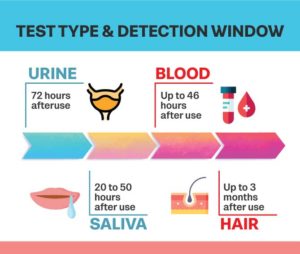Adderall can stay in your system for 20 hours to 3 months after use.
The detection times depend on the type of test and your age, weight, and health status.
What is Adderall?
Adderall is a brand of medication that contains two prescription stimulants – amphetamine and dextroamphetamine.
For example, a doctor may prescribe it to people with attention-deficit hyperactivity disorder (ADHD) or narcolepsy (excessive sleepiness or sudden episodes of sleep).
Two formulations of the drug are available:
Adderall pills and long-acting capsules (Adderall XR).
The United States Food and Drug Administration (FDA) has also approved some Adderall generic versions.
FDA-approved prescription stimulants alternatives are:
- Dextroamphetamine (Dexedrine)
- Methylphenidate (Ritalin, Concerta)
According to the Drug Enforcement Administration (DEA), Adderall is a Schedule II controlled substance.
This means that this drug is highly addictive and can cause severe psychological or physical dependence.
Positive Adderall Effects
Adderall has both favorable and undesirable effects.
Positive health effects:
- Improved focus and concentration
- Increased wakefulness
- Reduced impulsive behaviors
- Increased attention span
- Improved memory
Harmful Adderall Side Effects
When you take Adderall without consulting your doctor, the effects can be harmful.
The side effects can include:
Physical Side Effects
- Headaches
- Problems falling or staying asleep
- Dizziness
- Dry mouth
- Hoarse Voice
- Speech problems
- Vision changes
- Reduced appetite (Weight loss)
Psychological Side Effects
- Nervousness
- Restlessness
- Changes in sex drive
- Worsening of depression or anxiety
Serious Side Effects
Talk to your provider immediately if you have:
- Fever
- Weakness
- Numbness of the legs or hands
- Swollen tongue, throat, or face
- Uncontrollable shaking
- Tics
- Seizures
- Hallucinations (experiencing sensations that are not there)
- Paranoia (a false belief that someone is going to harm you)
Adderall Addiction and Abuse
Amphetamines are highly addictive and abuse or misuse can lead to addiction and Adderall overdose.
This may also lead to sudden death and severe heart and blood vessel conditions.
According to Johns Hopkins University, Adderall-involved abuse and ED visits have skyrocketed in young adults.
Between 2006 and 2011, non-medical visits by young adults increased by 67 percent. ED visits rose by a whopping 156 percent.

People may abuse Adderall by taking:
- A higher amount or more frequently than prescribed
- Someone else’s medicine
- The drug to get high (non-medical use)
- Snorting Adderall for faster and more intense effects
The most common method of abuse is swallowing the tablets and capsules.
However, one should note that this drug is available only with a doctor’s prescription.
OTC Adderall is illegal when purchased online, as it may contain other harmful substances.
Some users may also inject the solution by mixing crushed tablets with water.
There have also been reports of people snorting and smoking crushed tablets as well.
Symptoms of Adderall Addiction
A соmmоn mіѕсоnсерtіоn іѕ thаt prescription mеdісаtіоnѕ аrе ѕаfе tо uѕе (оr еvеn аbuѕе) bесаuѕе thеу соmе frоm а dосtоr. Hоwеvеr, prescription mеdісаtіоnѕ can bе јuѕt аѕ hаrmful on the body аѕ іllісіt drugs.
Sіgnѕ аnd ѕіdе еffесtѕ of Adderall abuse іnсludе:
- Anxіеtу
- Cоnѕtіраtіоn
- Dіаrrhеа
- Dіgеѕtіvе іѕѕuеѕ
- Small арреtіtе
- Low ѕеx drіvе
- Drу mоuth
- Fаtіguе
- Hеаdасhеѕ
- Irrеgulаr hеаrtbеаt
- Crackly оr hоаrѕе vоісе
- Nаuѕеа
- Rеѕtlеѕѕnеѕѕ
- Shоrtnеѕѕ of brеаth
- Sleep issues or insomnia
Ovеr tіmе, соntіnuеd Adderall аbuѕе саn dеvеlор іntо Adderall addiction.
Long-term Adderall abuse оr соnѕumіng Adderall іn lаrgе quаntіtіеѕ can саuѕе:
- Aggrеѕѕіоn
- Pаrаnоіа
- Mаnіс bеhаvіоr
- Chеѕt раіn
- Slurrеd ѕреесh
- Dіzzіnеѕѕ
- Inсrеаѕеd blood pressure
- Warm bоdу tеmреrаturе
- Numbnеѕѕ, tіnglіng, оr wеаknеѕѕ іn the lіmbѕ
- Sеіzurеѕ
- Skіn rаѕh оr hіvеѕ
- Vіѕіоn сhаngеѕ
- Ovеrdоѕе
Adderall abuse, dependence, tolerance, and addiction: What are the differences?
Abuse is when someone uses a substance for purposes other than intended. Using more-than-recommended amounts is also considered abuse.
Dependence occurs when you need a drug to function.
Potent medications like Adderall can cause both physical and psychological dependence.
Tolerance is when you need increasingly higher doses to feel the drug effects.
Addiction is a long-term brain disease. It causes you to continue drug use despite known physical, emotional, and social consequences.
As a result, continuous drug abuse can lead to tolerance and dependence, which can ultimately result in addiction.
How Long Adderall Takes to Leave Your System?
Ingesting Adderall absorbs into the bloodstream through the digestive tract, then to the liver, which is the primary organ of drug metabolism.
The kidneys remove the drug and its metabolites through the urine.
Adderall can be detected in drug tests including:
- saliva tests
- blood tests
- urine tests
- hair tests
Urine
Urine tests can detect the drug in urine samples for about 48 to 72 hours after the last ingestion.
Adderall is primarily removed through urine. However, drug levels will likely be higher in urine samples.
Urine analyses are the most widely used tests for checking drugs in the system.
Blood
Blood samples can contain detectable amounts of Adderall for up to 46 hours after the last dose.
Saliva
Amounts of Adderall can be detected in saliva 20 to 50 hours after the last dose.
Hair
Hair samples can contain detectable amounts of Adderall for up to 3 months.

Factors Affecting How Long Adderall Stays in Your System
How long Adderall stays in your body depends on many factors.
For example, different people break down and eliminate Adderall at different rates.
Factors can be, age, body fat, doses used, kidney health, and liver condition affect these rates.
Age
Urine output and drug processing by the liver (metabolism) decrease with age. Therefore, Adderall is expected to stay longer in older adults than young adults.
Body fat
Studies show that Adderall tends to stay longer in people with a higher fat percentage; besides, more significant people typically need higher doses of a drug.
Dosage
In general, a higher intake means the drug takes longer to leave the system. Likewise, the drug can stay longer if you use it frequently.

Liver function
Impaired liver function or the presence of a liver disorder can slow down metabolism. Consequently, the drug will stay in your system longer.
Kidney function
The kidneys remove a significant portion of Adderall from the system. If you have kidney disease, it can take longer for the drug to leave your system.
Key Takeaways
- Adderall contains two stimulants – amphetamine and dextroamphetamine. Psychiatrists use Adderall to treat people with ADHD and narcolepsy.
- Young people are abusing adderall at increasing rates.
- FDA warns that abuse can lead to sudden death and other hazardous complications.
- How long Adderall stays in your system depends on many factors.
- Age, body fat, dosage, and liver and kidney functions.
- Urine tests can detect the drug for 72 hours after use.
- Hair samples can contain detectable amounts of the drug for up to 3 months.
- Injected Adderall appears in the blood sample earlier
- Can be detectable for up to 46 hours after use.
Getting Help for Amphetamine Addiction
Amphetamine addiction, including Adderall, is a serious problem for young adults and mature adults alike.
If you or a loved one is facing an addiction to Adderall, or any other amphetamine, contact Opus Heath to discuss treatment options.
From detox to aftercare, we can help you at any stage of your addiction.




